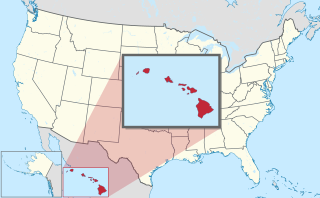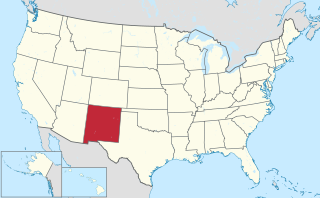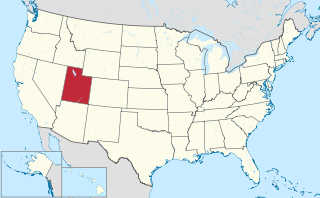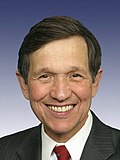
The 2004 United States presidential election in Connecticut took place on November 2, 2004, and was part of the 2004 United States presidential election. Voters chose seven representatives, or electors to the Electoral College, who voted for president and vice president.

The 2004 Maryland Democratic presidential primary took place on March 2, 2004 as part of the 2004 Democratic Party presidential primaries. The delegate allocation is proportional; candidates are awarded delegates in proportion to the percentage of votes received, open to registered Democrats only. Frontrunner John Kerry won the primary with former Senator John Edwards coming in a distant second.

The 1996 United States presidential election in Pennsylvania took place on November 5, 1996 as part of the 1996 United States presidential election. Voters chose 23 representatives, or electors to the Electoral College, who voted for president and vice president.

The 1984 United States presidential election in Pennsylvania took place on November 6, 1984, and was part of the 1984 United States presidential election. Voters chose 25 representatives, or electors to the Electoral College, who voted for president and vice president.

The 1936 United States presidential election in Pennsylvania took place on November 3, 1936 as part of the 1936 United States presidential election. Voters chose 36 representatives, or electors to the Electoral College, who voted for president and vice president.

The 1904 United States presidential election in Pennsylvania took place on November 8, 1904 as part of the 1904 United States presidential election. Voters chose 34 representatives, or electors to the Electoral College, who voted for president and vice president.

Since Alaska's admission to the Union in January 1959, it has participated in 16 United States presidential elections, always having 3 electoral votes. In the 1960 presidential election, Alaska was narrowly won by the Republican Party's candidate and incumbent vice president Richard Nixon, defeating the Democratic Party's candidate John F. Kennedy by a margin of just 1.88%. In the 1964 presidential election, the Democratic Party's candidate Lyndon B. Johnson won Alaska in a national Democratic landslide victory. Since the 1964 election, Alaska has been won by the Republican Party in every presidential election.

Since Arizona's admission to the Union in February 1912, it has participated in 28 United States presidential elections. In the 1912 presidential election, the incumbent president William Howard Taft finished fourth in Arizona, receiving just 12.75% of the popular vote. In the 1936 presidential election, the Democratic Party's candidate Franklin D. Roosevelt won Arizona, defeating the Republican Party's candidate Alf Landon by 42.92%, which remains the largest margin of victory in the state's history. Ross Perot, the independent candidate in the 1992 presidential election, received the highest vote share (23.79%) ever won by a third-party candidate in Arizona.

Arkansas is a state in the South Central region of the United States. Since its admission to the Union in June 1836, it has participated in 46 United States presidential elections. In the realigning 1860 election, Arkansas was one of the ten slave states that did not provide ballot access to the Republican nominee, Abraham Lincoln. Subsequently, John C. Breckinridge won the state by a comfortable margin, becoming the first third party candidate to win Arkansas. Soon after this election, Arkansas seceded from the Union and joined the Confederacy. Following the secession, Arkansas did not participate in the 1864 presidential election. After the Civil War, Arkansas was readmitted to the Union in 1868. In the 1872 election, all six of Arkansas's electoral votes were invalidated due to various irregularities including allegations of electoral fraud.

Since being admitted to the Union in 1850, California has participated in 43 presidential elections. A bellwether from 1888 to 1996, voting for the losing candidates only three times in that span, California has become a reliable state for Democratic presidential candidates since 1992.

Florida is a state in the South Atlantic region of the United States. Since its admission to the Union in March 1845, it has participated in every United States presidential elections. Florida participated in the presidential election for the first time in 1848. In this election, the Whig Party won Florida's three electoral votes with 57.20% of the vote, the only time the Whig Party won in Florida. In the realigning 1860 election, Florida was one of the ten slave states that did not provide ballot access to the Republican nominee, Abraham Lincoln. In the 1860 presidential election, John C. Breckinridge emerged victorious in Florida, winning 62.23% of the vote. Shortly after this election, Florida seceded from the Union and became a part of the Confederacy. Due to the secession, Florida did not participate in the 1864 presidential election. With the end of the Civil War, Florida rejoined the Union and participated in the 1868 presidential election. The 1868 election was the sole presidential contest in Florida not decided by popular vote, but instead by the state legislature. Florida voted for the Republican nominee in all three presidential elections during the Reconstruction era.

Hawaii is a state in the Western United States located in the Pacific Ocean about 2,000 miles from the U.S. mainland. Since its admission to the Union in August 1959, it has participated in 16 United States presidential elections. In the 1960 presidential election, Hawaii was narrowly won by the Democratic Party's candidate John F. Kennedy, defeating the Republican Party's candidate and incumbent vice president Richard Nixon by a margin of just 0.06%. In the 1964 presidential election, the Democratic Party's candidate Lyndon B. Johnson won Hawaii by a margin of 57.52%, which remains the largest ever margin of victory in the state's history. Since the 1960 election, Hawaii has been won by the Democratic Party in every presidential election, except in 1972 and 1984, which were both won in a national Republican landslide victory by Nixon and Ronald Reagan respectively.

Since New Mexico's admission to the Union in January 1912, it has participated in 28 United States presidential elections. In the 1912 presidential election, Theodore Roosevelt, the Progressive Party's nominee, received the highest vote share (17.1%) ever won by a third party candidate in New Mexico. In the 1932 presidential election, Democrat Franklin D. Roosevelt won New Mexico, defeating Republican Herbert Hoover by 26.96%, which remains the largest ever margin of victory in the state's history. In the 2000 presidential election, Democrat Al Gore won New Mexico, defeating Republican George W. Bush by a margin of just 0.06%.

Utah is a state in the Mountain West sub-region of the Western United States. Since its admission to the Union in January 1896, it has participated in 32 United States presidential elections. In the 1896 presidential election, first presidential election in which the state participated, Utah was won in a landslide by Democrat William Jennings Bryan, who received almost 83 percent of the state's vote. However, the state would quickly swing towards the Republican Party in the years that followed, although it would remain a swing state at the presidential level well into the 1940s. In the 1912 election, Utah was one of only two states won by incumbent Republican President William Howard Taft. However, the state would vote for the Democratic nominee by a large margin in 1916, 1932, 1936, 1940, and 1944, and by a narrow margin in 1948. However, since the latter election, the state has become very heavily Republican and has only voted for a Democratic presidential nominee once.

Since Wyoming's admission to the Union on July 10, 1890, it has participated in 33 United States presidential elections, always having 3 electoral votes. Wyoming was the first place in America to grant women the right to vote, in 1869, well before it joined the Union in 1890. This was a significant milestone for women's suffrage and paved the way for other states to follow suit. As a state with a strong Republican tradition, Wyoming tends to favor the Republican Party in presidential elections. It has consistently voted for Republican candidates in recent decades and is considered a reliably red state. When Wyoming participated in its first presidential election in 1892, Republican candidate Benjamin Harrison won the state with 50.52% of the vote. Harrison's Democratic opponent, Grover Cleveland, who went on to win the election, did not even appear on the ballot in Wyoming.

The District of Columbia is a political division coterminous with Washington, D.C., the capital city of the United States. Since the enactment of the 23rd amendment to the Constitution in 1961, the district has participated in 15 presidential elections. The amendment states that it cannot have more electoral votes than the state with the smallest number of electors. Since then, it has been allocated three electoral votes in every presidential election. The Democratic Party has immense political strength in the district. In each of the 15 presidential elections, the district has overwhelmingly voted for the Democratic candidate, with no margin less than 56.5 percentage points. It has been won by the losing candidate in 8 of the 15 elections.

The 1932 United States presidential election in Texas took place on November 8, 1932, as part of the 1932 United States presidential election, which was held throughout all contemporary 48 states. Voters chose 23 representatives, or electors to the Electoral College, who voted for president and vice president.

The 2004 Connecticut Democratic presidential primary was held on March 2 in the U.S. state of Connecticut as one of the Democratic Party's statewide nomination contests ahead of the 2004 presidential election.

The 2004 Georgia Democratic presidential primary was held on March 2 in the U.S. state of Georgia as one of the Democratic Party's statewide nomination contests ahead of the 2004 presidential election.

The 2004 Tennessee Democratic presidential primary was held on February 10 in the U.S. state of Tennessee as one of the Democratic Party's statewide nomination contests ahead of the 2004 presidential election. The primary determined 69 delegates to the 2004 Democratic National Convention, who were awarded on a proportional basis. John Kerry won with 41.02% of the vote and was awarded 31 delegates.






















